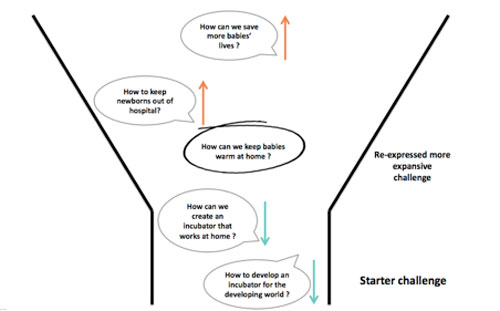
Faced with an urgent challenge or threat, most organisations will react by convening the staff who have the deepest experience in that issue, and asking them to come up with some fresh thinking.
And then they will be surprised when that group fails; after all, surely having deep experience is the best guarantee of innovation success?
In fact one of the biggest barriers to innovation in any organisation is what we call the ‘Experience Paradox’. The fact that a group of internal ‘experts’ will often find it far harder to think of new ways to get a job done than an individual or team seeing a problem through fresh eyes, and free from vested interests in the old ways of doing things.
If you have such a challenge, our advice is to gather your internal entrepreneurs and free thinkers, and set them to work instead in a framework that allows the room to operate like a start-up: questioning, challenging and being experimental.
In these times of rapid change, understanding how to unleash a spirit of entrepreneurship can be your salvation.
Our ?What If! Top Dog programme has allowed us behind the scenes access to some of the world’s leading and most entrepreneurial companies such as Method, Google and the New York Mayor’s office. We’ve distilled some of these principles and skills into activities and behaviours which, with the right training, can be adopted into large pharmaceutical corporations.
Stop before you start
Ensure you are asking the right questions. An entrepreneur using his own funds will never begin until he is ruthlessly sure he is addressing the right challenge.
In our experience in big business, leaders tend to do the opposite. The temptation for a speedy project start is often a missed opportunity for genuine early hypothesising and expansive thinking.
Despite the industry’s high levels of regulation, a focused and iterative approach can still be applied in pharma
How often does a project begin because it was agreed in the annual plan or because a global leader believed it would be useful? How often does the rest of the team just ‘get going’ because there’s a key timeline to hit, regardless of truly understanding the goals?
Genuinely stopping, looking at the brief, re-expressing the challenge in a more expansive way, forcing yourself to look outside of your typical competitive set and project scope, can unlock new and more innovative approaches to problem solving.
The graphic below shows how using the ‘expansive funnel’ approach can do this. For example the well known ‘Embrace’ sleeping bag style baby warmer might never have been conceived, had the creators only ever looked at inventing a lower cost incubator.
Expansive scoping to define new potential solutions
Example: The creation of the Embrace baby warmer in the developing world

Get up close and personal
Typically the rational, obvious patient and HCP needs and solutions will be deeply understood through in-depth data and analysis, and will already be part of a pipeline of development strategy; these have been the bedrock of clinical-led innovation for decades.
However, we frequently find it is the more human and emotional needs such as safety, love and belonging and self-esteem, which go unnoticed or unexplored in pharma. They are harder to quantify in a study, draw on a graph or use in a tangible business case yet they are the constant human needs that motivate both patients and physicians.
The pharma industry is fond of measuring the objective clinical outcomes of new medicines and aiming for improvements in these ‘scores’ in their development. For a cancer drug this will be a combination of overall survival, progression-free survival, tolerability, safety and so on, for an asthma drug it may be simpler, such as number of exacerbations or peak flow-meter scores.
However, these measures are not how patients and many physicians typically measure successful outcomes. Time and again patients with advanced cancer tell us that their goal is ‘the continuation of normal family life’, while asthma patients will say that successful treatment can be measured in being able to dance, run, or even just go outdoors in the springtime.
These more emotional measures of success will be far more enduring as ‘aiming points’ than clinical metrics, if you can build them into your research and development efforts.
In times of rapid change, experience could be your worst enemy – J Paul Getty
An entrepreneur seeking investment may not have the big research budgets, but he will have spent time upfront truly understanding what his potential customers may intuitively want. Typically, he will continually check in with his customer throughout the development cycle.
Blending these more insightful skills with the power of big budget research can unlock genuine competitive advantage.
Experiment quickly and cheaply
Once you’ve built starter ideas on rigorous human need foundations, it’s usually time to face the next big series of obstacles. How will you bring the solution to market? How will you know if you’re on the right track? What structures will you need to put in place to deliver?
Entrepreneurs are often time and cash strapped, so they need a ruthless focus on how they can move forward at minimum cost.
Rather than develop costly pilots for new ideas, they break out the critical assumptions that need to be true for the idea to succeed and create fast and cheap experiments to validate the most uncertain of their critical assumptions.
For example, when IBM decided to explore voice recognition technology, it could have immediately dived into spending a fortune on solving the technical challenges. But it knew that all this investment would be wasted if one critical assumption wasn’t true; that people would be prepared to speak out loud to a computer.
Its initial ‘entrepreneur’s experiment’ involved faking the technology for just a few hundred dollars, by having a computer connected by microphone to a speed typist in another room, and asking potential users to speak into the computer, and see their words instantly appear on the screen.
Having established that people would in fact speak into a computer, though not for very long, it was able to move to solving the more technical and expensive challenges ahead.
Despite the obvious high levels of regulation, the focused but iterative nature of this style of approach can be equally applied in pharma to anything from sales aids, CRM systems or devices getting to market faster with expensive mistakes being prevented. It’s also one of the single best ways to ensure stakeholder belief and buy in at an early stage.
Show some passion
There’s a world of difference between a person or team who try to advance an idea in a ‘neutral’ way; being dispassionate, relying on the data to sell and entrepreneurs who sell their ideas constantly, as if their lives depended on it.
We find that this genuine passion for an idea is often lacking in larger companies where the understandable need for process and stage gates mean that personal connection, advocacy and passion have been enormously diluted.
If you can’t find it in yourself to have an entrepreneur’s passion about your project or solution, how can anyone else be expected to care?





